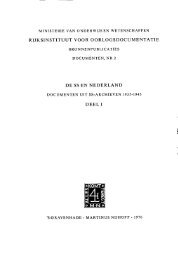De razzia van Rotterdam. 10-11 november 1944 - KNAW
De razzia van Rotterdam. 10-11 november 1944 - KNAW
De razzia van Rotterdam. 10-11 november 1944 - KNAW
Create successful ePaper yourself
Turn your PDF publications into a flip-book with our unique Google optimized e-Paper software.
2 7 2 SUMMARY<br />
instance many thousands of men were assembled in <strong>Rotterdam</strong>’s largest football<br />
stadium which lies south of the river Maas. They were lined up on the field. Machine<br />
guns had been installed on the stands and on platforms which had been raised on<br />
the corners of the field. Rain was falling and the men were soaked. They had to stand<br />
for hours in the open. Many of them had had little food or no food at all and<br />
some, especially those who were ill or weak were unable to remain standing and<br />
feil to the ground. In the evening thousands of them tried to find refuge in the<br />
corridors and in the various rooms of the stadium’s building. They tried to snatch<br />
some sleep. It was bitterly cold. All corridors were overcrowded. There was no<br />
question of quiet and the general nervousness increased.<br />
Generally all exemption papers and statements, given by members of the medical<br />
profession were completely ignored. Only a few doctors who had also been forced<br />
to report succeeded in persuading the Germans to release a limited number of people.<br />
Most of the men who had been taken to the assembly areas were in a mood of<br />
resignation. This was not only a result of the strain of the entire day, of tiredness and<br />
hunger. The fact that they were guarded by a heavily armed enemy who had proved<br />
a merciless foe during four years of war, was the dominating factor. Apart from this<br />
the groups in the assembly area consisted of people from all walks of life who in the<br />
normal course of events would have little contact. Sometimes demonstrations broke<br />
out in the form of singing. A few men tried to offer individual resistance. German<br />
reaction was quick and nowhere were the men able to form an active, coherent group,<br />
able and willing to offer coordinated resistance.<br />
Usually small groups were formed by people who knew each other as friends,<br />
neighbours, colleagues or as members of the same church. Endless discussions took<br />
place as to the aim of the <strong>razzia</strong> and the destination of its victims. They tried to kill<br />
time playing cards; there were also some “comedians” who tried to cheer up the<br />
others.<br />
As has already been stated, the <strong>razzia</strong> was carried out in Schiedam and in the<br />
outer suburbs districts of <strong>Rotterdam</strong> on November <strong>10</strong>. In the town’s inner central<br />
district the <strong>razzia</strong> was carried out one day later. There, on November <strong>10</strong> there were<br />
rumours that a <strong>razzia</strong> was being held in the outer areas; no one knew however, how<br />
and with what means the <strong>razzia</strong> was taking place. Many people were entirely unaware<br />
of what was happening elsewhere. On November <strong>11</strong> the Germans were able to<br />
concentrate their troops on a smaller area than the preceding day. Their success was<br />
equally striking. Again from the assembly areas the men were led to the places of<br />
departure.<br />
THE TRANSPORTS<br />
During the marches through the town the men were heavily guarded. Those trying<br />
to stay behind were pushed along. The Germans had their guns aimed at the men,<br />
sometimes they fired shots over their heads. Women, children and old people lined






